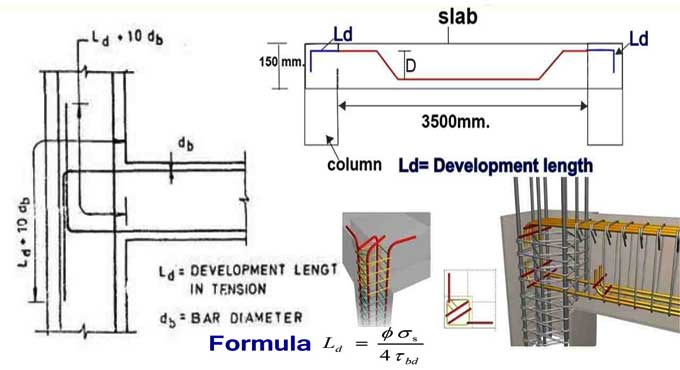NEWS | SOFTWARE | SHEET
Proper Guidelines for Calculating the Development Length of Reinforcement Bars
The process of construction does not happen overnight. Completing this process can take months or even years. This process is influenced greatly by the length of development. To establish the desired bond strength between concrete and steel, the development length is the amount of reinforcement to embed or project into the column.
It is the length of the bar needed to transfer the stress to the concrete that can be defined as the development length. Development length refers to the amount of rebar that is required to be enclosed in concrete to achieve the required bond strength between materials and, in addition, to ensure the steel is stressed at that area.
Reason for Providing Development length of Reinforcement Bar
In order to prevent failure due to slippage of the bar during ultimate load conditions, the surface of the bar should be securely bonded to the concrete to prevent slippage. A bar that is supplied with additional length for development transfers stresses between sections.
Steel Distance
If the distance between the steel members is increased, more concrete is required to prevent horizontal shearing. Other kinds of members, such as beams, usually have steel spaced at greater distances, reducing the amount of development length required.
It is common for steel to be separated by one to two steel diameters in beams, but in other types of members steel is separated by a greater distance.
Compressive Concrete Resistance
An increase in compressive strength will result in a shorter development length, since compression strength and development length are inversely related.
Steel Coating
Some construction projects use epoxy-coated steels instead of ordinary steels since the structures will be exposed to conditions causing corrosion. In order to increase concrete and steel adhesion strength, it is necessary to prolong the development period.
Steel Diameter
The diameter of the steel affects the development length. The development length required for steel with a smaller diameter is shorter than that required for steel with a larger diameter, everyone has noticed. Increases in development length result in increased steel diameter.
Concrete Density
It is determined by the concrete's density how long it takes to develop. The development time will be extended either if low density concrete is used or if high density concrete is used.
Structural Steel Encased in Concrete
A concrete covering for steel can also affect the length of the development process. Shortening the development length will result from increasing concrete cover thickness.
Development Length of Reinforcement Bar Importance
Construction practices that promote safety require appropriate development. As per the steel grade considered in the design, reinforcement bars should have the proper development length. A structure, if developed less than the required length, is prone to failure due to slippage of joints, bonds, anchors, and laps. Such failures happen at joints and laps prior to reinforcement bars yielding in such cases.
Development Length Calculation
Ld = σ st φ/4τ bd
Any given bar diameter can be calculated using the above formula, which is expressed as a length in mm. Limit state method and working stress method both use the same formula. Difference in design bond stress is the only difference between the two methods in the calculation.
For the concrete steel bond to stay continuous, you need a development length of 10 DB at the end of the example. Only 90 degree configurations are used, but you can use more configurations. The bar is bent because the end section does not have any space.
In order to produce the desired compression or tension reinforcement on both sides of a RC member, hooks or mechanical gadgets are attached to the length on both sides.
When the restraining section of concrete is very thin and cannot support the position of highly stressed bars, the development length is provided. The bars are thus prevented from splitting from the concrete.
In the development length, there is an additional embedded length. Providing proper support and stability to the bars is the main objective. Compression reinforcement does not provide hooks, but hooks can be used as restraints when extra length is not available.
To get more details, go through the following video tutorial.
Lecturer: Civil Engineers
Development Length in Different Situations
Column
Column bars penetrate and remain embedded within the footing concrete for the length of compression development length. As the column bar penetrated and remained embedded within the footing concrete, it also flexed in tandem with the footing reinforcement. This refers to the length of tension development created by the column bar.
Beam
As a result of the beam intersections, the development length is extended. Steel and concrete bonding transmits stress extremely well as a result.
Compression & Tension
During axial compression, the term development length in compression refers to bars embedded in concrete, while development length in tension refers to concrete that is under flexural compression.


